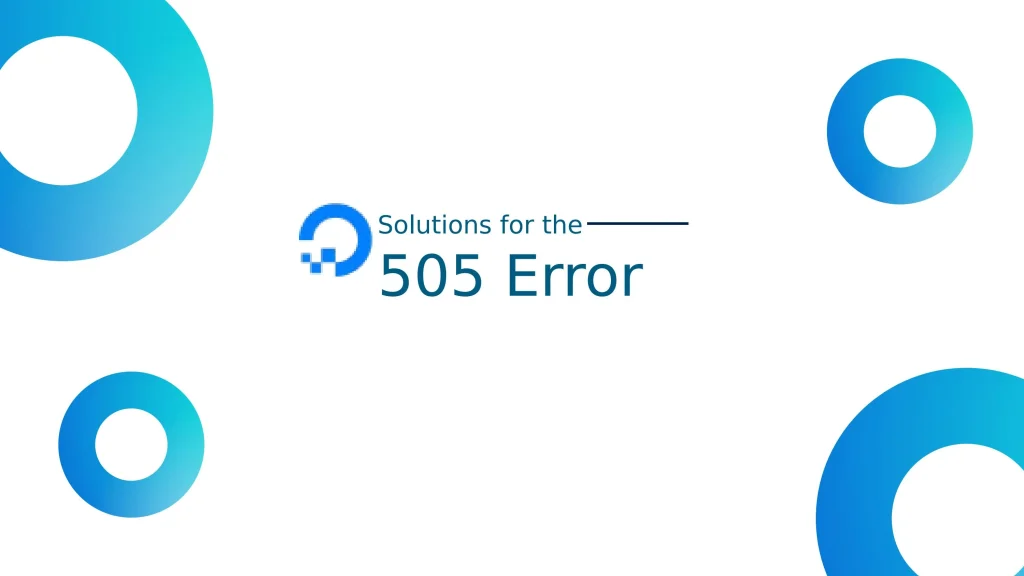Errors are an inevitable part of our internet exploration, and one such disruptive issue is the 505 error. When faced with this error, understanding its meaning and discovering effective solutions are essential. This article will delve into the significance of the 505 error, explore its root causes, and provide the best methods to resolve it, ensuring a smoother browsing experience for users.
 A 505 error, also known as HTTP Version Not Supported, is a server-side error that occurs when the server does not support the HTTP protocol version used by the client.
The server understands the request but cannot fulfill it due to the incompatible protocol version. The HTTP 505 error is one such error that is cryptic and perpleA 505 error, also known as HTTP Version Not Supported, occurs on the server-side when the server cannot handle the HTTP protocol version used by the client making the request.
Unlike other server errors like 500 Internal Server Error or 502 Bad Gateway, which signify different issues, the HTTP 505 error is somewhat cryptic and puzzling, seemingly appearing out of nowhere.
Understanding these 505 errors is crucial for web developers, system administrators, and users alike, as it helps diagnose and troubleshoot communication issues between clients and servers effectively.
Unfortunately, there is a lack of comprehensive resources available online about the HTTP 505 error. Hence, in this article, we aim to provide you with a detailed guide, explaining its meaning and presenting the best methods to resolve it.
Let us check them out!
A 505 error, also known as HTTP Version Not Supported, is a server-side error that occurs when the server does not support the HTTP protocol version used by the client.
The server understands the request but cannot fulfill it due to the incompatible protocol version. The HTTP 505 error is one such error that is cryptic and perpleA 505 error, also known as HTTP Version Not Supported, occurs on the server-side when the server cannot handle the HTTP protocol version used by the client making the request.
Unlike other server errors like 500 Internal Server Error or 502 Bad Gateway, which signify different issues, the HTTP 505 error is somewhat cryptic and puzzling, seemingly appearing out of nowhere.
Understanding these 505 errors is crucial for web developers, system administrators, and users alike, as it helps diagnose and troubleshoot communication issues between clients and servers effectively.
Unfortunately, there is a lack of comprehensive resources available online about the HTTP 505 error. Hence, in this article, we aim to provide you with a detailed guide, explaining its meaning and presenting the best methods to resolve it.
Let us check them out!
 In this example, a client has made a request using an HTTP protocol version that the server does not support. As a result, the server responds with a 505 HTTP Version Not Supported status code, along with a brief message explaining the issue. This response indicates that the server cannot fulfill the request due to the incompatible HTTP version.
In this example, a client has made a request using an HTTP protocol version that the server does not support. As a result, the server responds with a 505 HTTP Version Not Supported status code, along with a brief message explaining the issue. This response indicates that the server cannot fulfill the request due to the incompatible HTTP version.
 As the saying goes, “Prevention is better than cure,” and adopting preventive measures can significantly reduce future issues. Here are some of the best preventive steps you can follow to minimize the occurrence of 505 errors and ensure a smooth browsing experience:
As the saying goes, “Prevention is better than cure,” and adopting preventive measures can significantly reduce future issues. Here are some of the best preventive steps you can follow to minimize the occurrence of 505 errors and ensure a smooth browsing experience:
What is HTTP 505 Error?
 A 505 error, also known as HTTP Version Not Supported, is a server-side error that occurs when the server does not support the HTTP protocol version used by the client.
The server understands the request but cannot fulfill it due to the incompatible protocol version. The HTTP 505 error is one such error that is cryptic and perpleA 505 error, also known as HTTP Version Not Supported, occurs on the server-side when the server cannot handle the HTTP protocol version used by the client making the request.
Unlike other server errors like 500 Internal Server Error or 502 Bad Gateway, which signify different issues, the HTTP 505 error is somewhat cryptic and puzzling, seemingly appearing out of nowhere.
Understanding these 505 errors is crucial for web developers, system administrators, and users alike, as it helps diagnose and troubleshoot communication issues between clients and servers effectively.
Unfortunately, there is a lack of comprehensive resources available online about the HTTP 505 error. Hence, in this article, we aim to provide you with a detailed guide, explaining its meaning and presenting the best methods to resolve it.
Let us check them out!
A 505 error, also known as HTTP Version Not Supported, is a server-side error that occurs when the server does not support the HTTP protocol version used by the client.
The server understands the request but cannot fulfill it due to the incompatible protocol version. The HTTP 505 error is one such error that is cryptic and perpleA 505 error, also known as HTTP Version Not Supported, occurs on the server-side when the server cannot handle the HTTP protocol version used by the client making the request.
Unlike other server errors like 500 Internal Server Error or 502 Bad Gateway, which signify different issues, the HTTP 505 error is somewhat cryptic and puzzling, seemingly appearing out of nowhere.
Understanding these 505 errors is crucial for web developers, system administrators, and users alike, as it helps diagnose and troubleshoot communication issues between clients and servers effectively.
Unfortunately, there is a lack of comprehensive resources available online about the HTTP 505 error. Hence, in this article, we aim to provide you with a detailed guide, explaining its meaning and presenting the best methods to resolve it.
Let us check them out!
505 Status Code Example
To better understand the 505 error, consider the following example: In this example, a client has made a request using an HTTP protocol version that the server does not support. As a result, the server responds with a 505 HTTP Version Not Supported status code, along with a brief message explaining the issue. This response indicates that the server cannot fulfill the request due to the incompatible HTTP version.
In this example, a client has made a request using an HTTP protocol version that the server does not support. As a result, the server responds with a 505 HTTP Version Not Supported status code, along with a brief message explaining the issue. This response indicates that the server cannot fulfill the request due to the incompatible HTTP version.
Understanding the 5xx Series of HTTP Status Codes
The 5xx series of HTTP status codes are server error responses, which means that the server encountered an issue while processing the client’s request. The 5xx series is generated when something goes wrong on the server’s end, unlike the 4xx series, which indicates client errors. The server sends these status codes to let the client know that the request could not be fulfilled due to a problem with the server. Here are some of the commonly encountered 5xx HTTP status codes:-
500 Internal Server Error:
-
501 Not Implemented:
-
502 Bad Gateway:
-
503 Service Unavailable:
-
504 Gateway Timeout:
-
505 HTTP Version Not Supported:
Causes of a 505 Error
A 505 error can be triggered by several reasons:-
Outdated or unsupported HTTP protocol versions:
-
Incompatibility between client and server versions:
-
Server misconfiguration or software bugs:
- Sending an HTTP/2 request to a server that only supports HTTP/1.1 will cause a 505 error.
- Having any whitespace after the HTTP version in the request can trigger a 505 error.
- If the client is anything other than a web browser, a 505 error may occur.
How a 505 Error is Handled?
When a server encounters a 505 HTTP status code (HTTP Version Not Supported), it indicates that the server does not support the HTTP protocol version used in the client’s request. Handling a 505 error typically involves the following steps:-
Sending the appropriate HTTP response:
-
Providing version information:
-
Checking for misconfigurations and software bugs:
-
Upgrading server software:
-
Implementing version negotiation:
-
Providing informative error messages:
How to Fix HTTP 505 Error?
Fixing an HTTP 505 error (HTTP Version Not Supported) involves identifying the cause of the error and implementing the appropriate solutions. Here are some steps to troubleshoot and fix the issue:-
Check the HTTP version:
-
Update server software:
-
Enable HTTP version support:
-
Check for server misconfigurations:
-
Inspect server logs:
-
Version negotiation:
-
Test with different clients:
-
Update client software:
-
Contact your hosting provider:
-
Seek community support:
Best Practices to Prevent 505 Errors
 As the saying goes, “Prevention is better than cure,” and adopting preventive measures can significantly reduce future issues. Here are some of the best preventive steps you can follow to minimize the occurrence of 505 errors and ensure a smooth browsing experience:
As the saying goes, “Prevention is better than cure,” and adopting preventive measures can significantly reduce future issues. Here are some of the best preventive steps you can follow to minimize the occurrence of 505 errors and ensure a smooth browsing experience:
-
Keep server software up to date:
-
Ensure compatibility between client and server versions:
-
Perform regular testing and monitoring:
-
Utilize version negotiation techniques:




